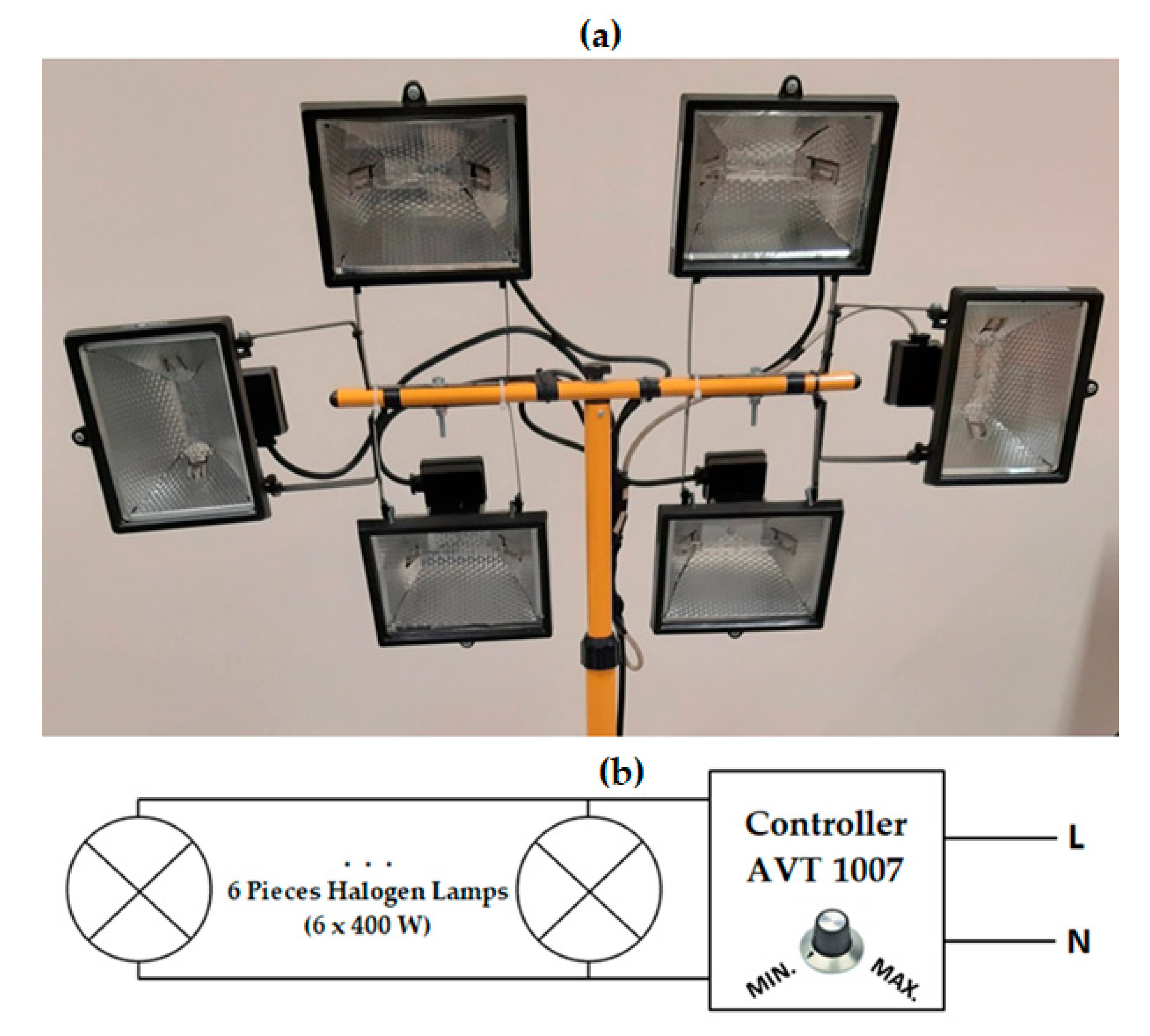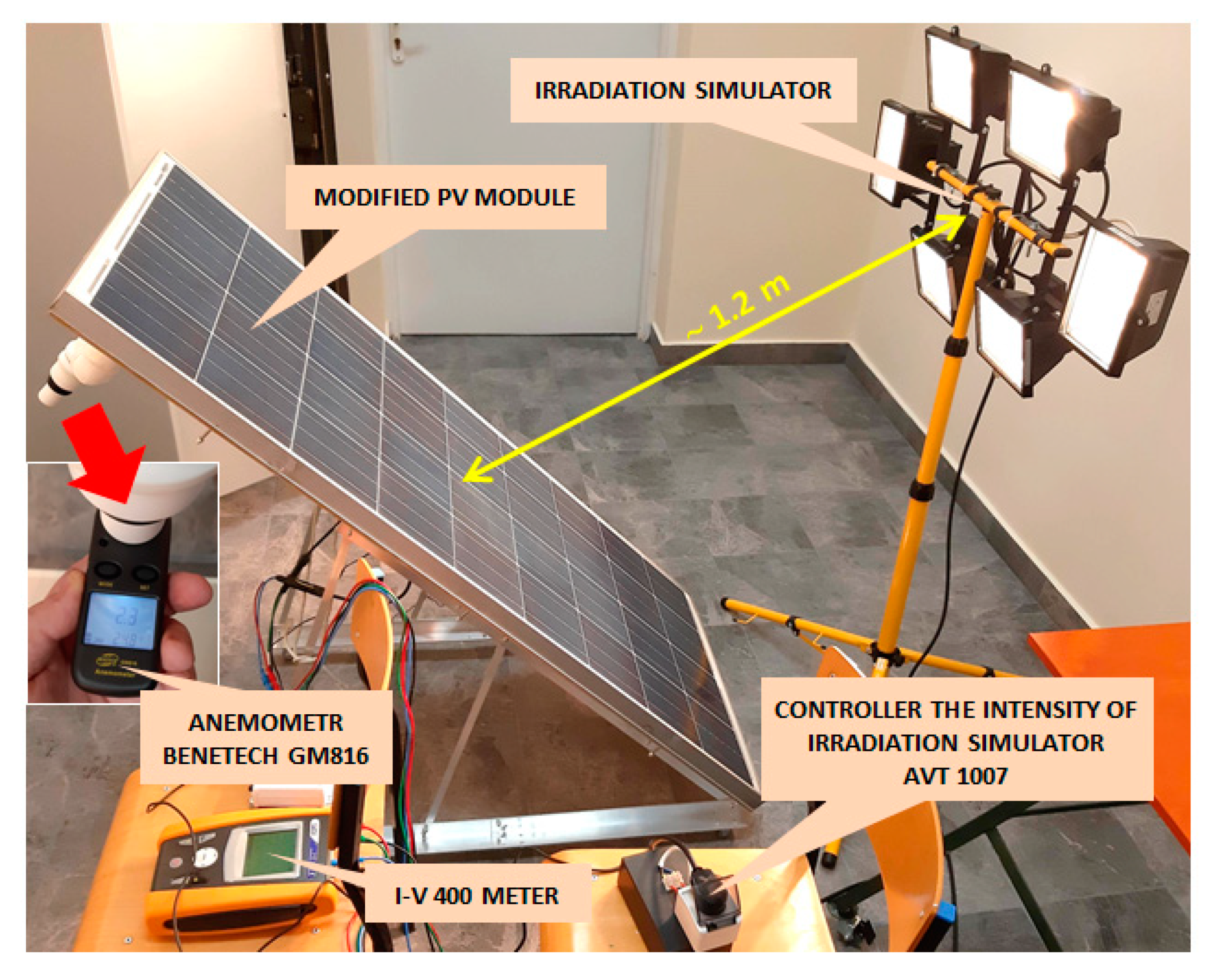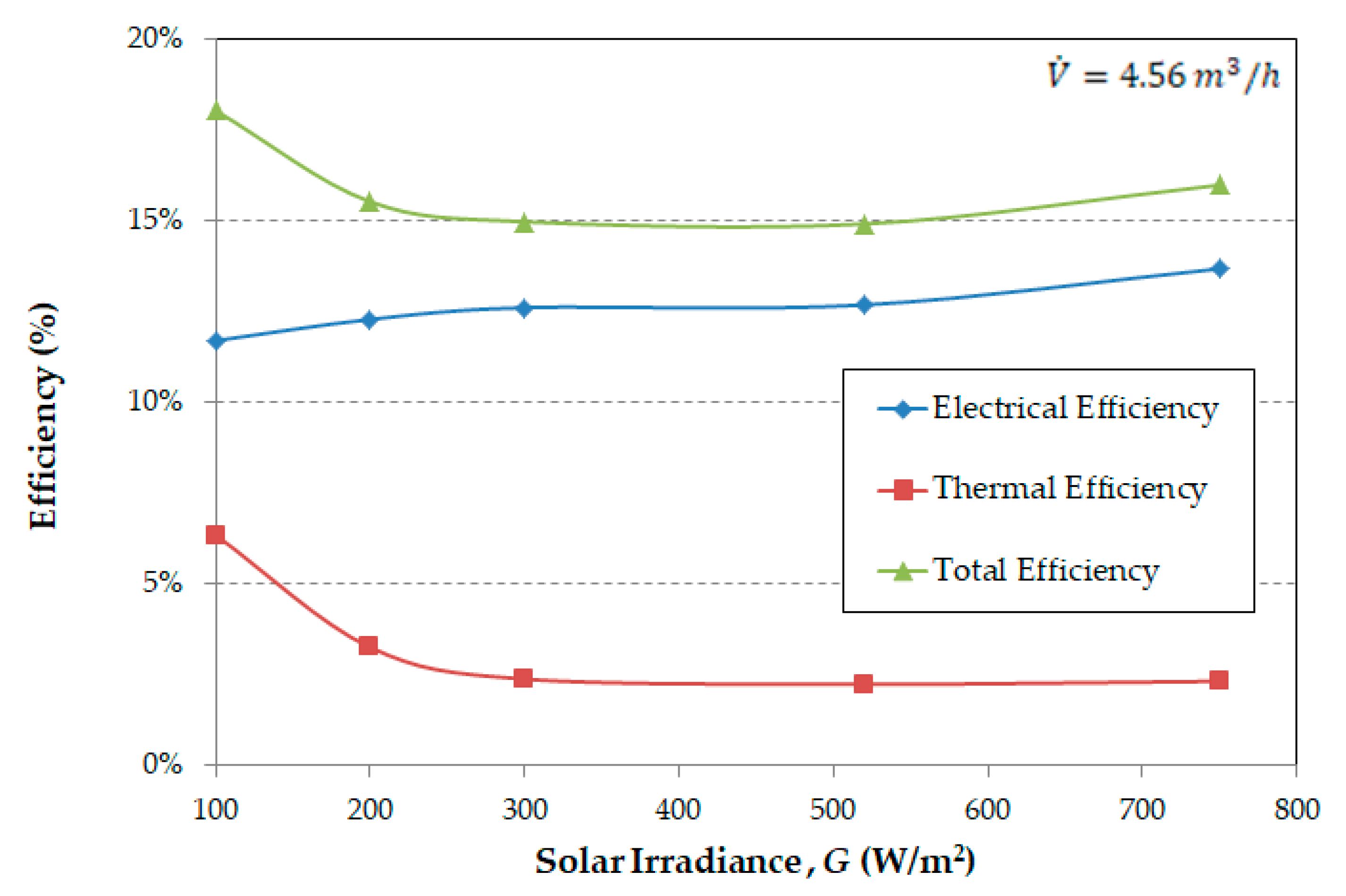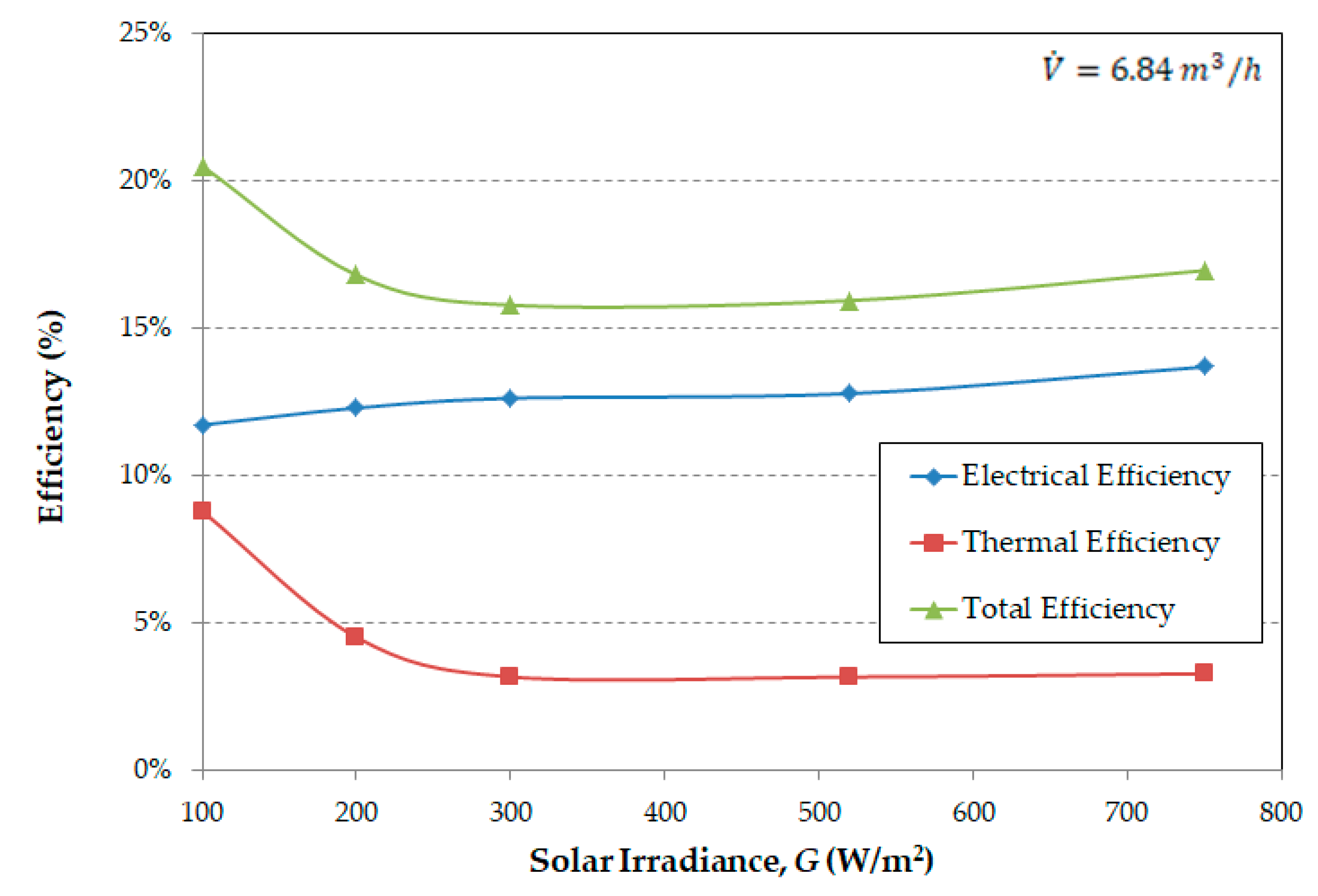The Efficiency of Obtaining Electricity and Heat from the Photovoltaic Module under Different Irradiance Conditions
Abstract
:1. Introduction
2. Materials and Methods
2.1. Construction of the Modified PV Module
2.2. Construction of the Solar Light Pseudo Simulator
2.3. The Experimental Research Setup
3. Results
4. Discussion
5. Conclusions
6. Directions for Future Research
Funding
Institutional Review Board Statement
Informed Consent Statement
Data Availability Statement
Conflicts of Interest
References
- Conibeer, G.; Willoughby, A. Solar Cell Materials: Developing Technologies, 1st ed.; John Wiley & Sons: Hoboken, NJ, USA, 2014; ISBN 978-1-118-69581-4. [Google Scholar]
- Hegedus, S.; Luque, A. Handbook of Photovoltaic Science and Engineering, 2nd ed.; John Wiley & Sons: Hoboken, NJ, USA, 2011; ISBN 978-0-471-49196-5. [Google Scholar]
- Messenger, R.A.; Ventre, A. Photovoltaic Systems Engineering, 4th ed.; CRC Press Taylor & Francis Group: Boca Raton, FL, USA, 2017; ISBN 978-1-4398-0293-9. [Google Scholar]
- Kalogirou, S. McEvoy’s Handbook of Photovoltaics, 3rd ed.; Elsevier: Amsterdam, The Netherlands, 2018; ISBN 9780128099216. [Google Scholar]
- Sarniak, M.T. Photovoltaic Systems; Warsaw University of Technology Publishing House: Warsaw, Poland, 2021; ISBN 978-83-7814-926-2. (In Polish) [Google Scholar]
- Zdyb, A.; Gulkowski, S. Performance assessment of four different photovoltaic technologies in Poland. Energies 2020, 13, 196. [Google Scholar] [CrossRef] [Green Version]
- Sarniak, M.T. Researches of the Impact of the Nominal Power Ratio and Environmental Conditions on the Efficiency of the Photovoltaic System: A Case Study for Poland in Central Europe. Sustainability 2020, 12, 6162. [Google Scholar] [CrossRef]
- Dziennik Ustaw, R.P. poz. 478. USTAWA z Dnia 20 Lutego 2015 r. o Odnawialnych Źródłach Energi. Available online: http://isap.sejm.gov.pl/isap.nsf/DocDetails.xsp?id=wdu20150000478 (accessed on 5 February 2021).
- My Electricity. Available online: https://mojprad.gov.pl/ (accessed on 4 February 2021).
- Energy Policy of Poland until 2040. Available online: https://www.gov.pl/documents/33372/436746/PEP2040_projekt_v12_2018-11-23.pdf/ee3374f4-10c3-5ad8-1843-f58dae119936 (accessed on 2 February 2021).
- Sarniak, M. Analysis of energy efficiency of photovoltaic installation in central Poland. In E3S Web of Conferences; EDP Sciences: Les Ulis, France, 2018; Volume 46, p. 00002. [Google Scholar] [CrossRef]
- Sarniak, M. Analiza efektywności energetycznej oraz rozkładu mocy wyjściowej falownika dla mikroinstalacji fotowoltaicznej w aspekcie procesu projektowania. Rynek Energii 2020, 2, 37–43. (In Polish) [Google Scholar]
- Kalogirou, S.A.; Tripanagnostopoulos, Y. Hybrid PV/T solar systems for domestic hot water and electricity production. Energy Convers. Manag. 2006, 47, 3368–3382. [Google Scholar] [CrossRef]
- Moharram, K.A.; Abd-Elhady, M.S.; Kandil, H.A.; El-Sherif, H. Enhancing the performance of photovoltaic panels by water cooling. Ain Shams Eng. J. 2013, 4, 869–877. [Google Scholar] [CrossRef] [Green Version]
- Kim, J.-H.; Park, S.-H.; Kim, J.-T. Experimental Performance of a Photovoltaic-thermal Air Collector. Energy Procedia 2014, 48, 888–894. [Google Scholar] [CrossRef] [Green Version]
- Amelia, A.R.; Irwan, Y.M.; Irwanto, M.; Leow, W.Z.; Gomesh, N.; Safwati, I.; Anuar, M.A.M. Cooling on Photovoltaic Panel Using Forced Air Convection Induced by DC Fan. Int. J. Electr. Comput. Eng. 2016, 6, 526. [Google Scholar] [CrossRef]
- Hegazy, A.A. Comparative study of the performances of four photovoltaic/thermal solar air collectors. Energy Convers. Manag. 2000, 41, 861–881. [Google Scholar] [CrossRef]
- Wajs, J.; Golabek, A.; Bochniak, R. Photovoltaic Roof Tiles: The Influence of Heat Recovery on Overall Performance. Energies 2019, 12, 4097. [Google Scholar] [CrossRef] [Green Version]
- Wajs, J.; Golabek, A.; Bochniak, R.; Mikielewicz, D. Air-cooled photovoltaic roof tile as an example of the BIPVT system—An experimental study on the energy and exergy performance. Energy 2020, 197, 117255. [Google Scholar] [CrossRef]
- El Manssouri, O.; Hajji, B.; Tina, G.M.; Gagliano, A.; Aneli, S. Electrical and Thermal Performances of Bi-Fluid PV/Thermal Collectors. Energies 2021, 14, 1633. [Google Scholar] [CrossRef]
- Panchenko, V.; Izmailov, A.; Kharchenko, V.; Lobachevskiy, Y. Photovoltaic Solar Modules of Different Types and Designs for Energy Supply. Int. J. Energy Optim. Eng. 2020, 9, 74–94. [Google Scholar] [CrossRef]
- Panchenko, V.A. Solar Roof Panels for Electric and Thermal Generation. Appl. Sol. Energy 2018, 54, 350–353. [Google Scholar] [CrossRef]
- AABCOOLING Black Silent Fan 8. Available online: https://www.aab.com.pl/product-pol-175-AABCOOLING-Black-Silent-Fan-8.html (accessed on 22 February 2021).
- Anemometer Benetech GM816. Available online: https://benetech-poland.pl/anemometry-wiatromierze/13-anemometr-wiatromierz-benetech-gm-816-5903738810291.html (accessed on 25 March 2021).
- PWM Controller ZTA31762. Available online: https://nia.gov.kn/wosumeSpeed-Controller-Low-Voltage-DC-18V-to-15V-2A-Mini-PWM-Motor-Speed-Controller-Regulator-Control-Module-p-71970/ (accessed on 30 March 2021).
- Controller AVT 1007. Available online: https://serwis.avt.pl/manuals/AVT1007.pdf (accessed on 12 March 2021).
- Lee, J.-H.; You, Y.-J.; Saeed, M.A.; Kim, S.H.; Choi, S.-H.; Kim, S.; Lee, S.Y.; Park, J.-S.; Shim, J.W. Undoped tin dioxide transparent electrodes for efficient and cost-effective indoor organic photovoltaics (SnO2 electrode for indoor organic photovoltaics). NPG Asia Mater. 2021, 13, 43. [Google Scholar] [CrossRef]
- Saeed, M.A.; Kang, H.C.; Yoo, K.; Asiam, F.K.; Lee, J.-J.; Shim, J.W. Cosensitization of metal-based dyes for high-performance dye-sensitized photovoltaics under ambient lighting conditions. Dye. Pigment. 2021, 194, 109624. [Google Scholar] [CrossRef]
- Gan, G. Simulation of buoyancy-induced flow in open cavities for natural ventilation. Energy Build. 2006, 38, 410–420. [Google Scholar] [CrossRef]
- Arifin, Z.; Prasetyo, S.D.; Prabowo, A.R.; Tjahjana, D.D.D.P.; Rachmanto, R.A. Effect of thermal collector configuration on the photovoltaic heat transfer performance with 3D CFD modeling. Open Eng. 2021, 11, 1076–1085. [Google Scholar] [CrossRef]
- Kharchenko, V.; Panchenko, V.; Tikhonov, P.V.; Vasant, P. Cogenerative PV Thermal Modules of Different Design for Autonomous Heat and Electricity Supply. In Handbook of Research on Renewable Energy and Electric Resources for Sustainable Rural Development; Kharchenko, V., Vasant, P., Eds.; IGI Global: Hershey, PA, USA, 2018; pp. 86–119. [Google Scholar] [CrossRef] [Green Version]









| Technical Data in STC | Value |
|---|---|
| PV Module Model | CL130-12 |
| Solar Cell (5 inches ≈ 125 × 125 (mm)) | Polycrystalline Silicon |
| No. of Cells (pcs.) | 36 |
| Maximum Power Point (MPP), (Wp) | 130 |
| Voltage in MPP, (V) | 17.2 |
| Current in MPP, (A) | 7.56 |
| Open Circuit Voltage, (V) | 21.6 |
| Short Circuit Current, (A) | 8.02 |
| Electrical efficiency, (%) | 13.5 |
| Dimensions of PV Module, (mm) | 1483 × 665 × 35 |
| G (W/m2) | Tamb (°C) | TM (°C) | PMPP (W) | ηel (%) |
|---|---|---|---|---|
| 100 | 23.4 | 26.5 | 11.63 | 11.80 |
| 200 | 23.8 | 30.1 | 23.86 | 12.10 |
| 300 | 24.4 | 33.7 | 37.63 | 12.72 |
| 520 | 20 | 36.2 | 64.4 | 12.56 |
| 750 | 21 | 44.4 | 101.4 | 13.71 |
| G (W/m2) | TM (°C) | ΔT (°C) | PMPP (W) | ηel (%) | q (W/m2) | ηth (%) | ηtot (%) |
|---|---|---|---|---|---|---|---|
| 100 | 33 | 4.1 | 11.53 | 11.69 | 6.34 | 6.34 | 18.03 |
| 200 | 32.8 | 4.2 | 24.21 | 12.28 | 6.49 | 3.25 | 24.75 |
| 300 | 42.8 | 4.6 | 37.27 | 12.60 | 7.11 | 2.37 | 14.97 |
| 520 | 43.2 | 7.5 | 65.01 | 12.68 | 11.59 | 2.23 | 14.91 |
| 750 | 46.6 | 11.2 | 101.1 | 13.67 | 17.31 | 2.31 | 15.98 |
| G (W/m2) | TM (°C) |
ΔT (°C) | PMPP (W) | ηel (%) | q (W/m2) | ηth (%) | ηtot (%) |
|---|---|---|---|---|---|---|---|
| 100 | 32.5 | 3.8 | 11.55 | 11.71 | 8.79 | 8.79 | 20.50 |
| 200 | 37.7 | 3.9 | 24.23 | 12.29 | 9.02 | 4.51 | 16.80 |
| 300 | 41.9 | 4.1 | 37.32 | 12.62 | 9.48 | 3.16 | 15.78 |
| 520 | 42.8 | 7.2 | 65.5 | 12.78 | 16.65 | 3.20 | 15.98 |
| 750 | 46.3 | 10.6 | 101.2 | 13.68 | 24.51 | 3.27 | 16.95 |
| G (W/m2) | TM (°C) | ΔT (°C) | PMPP (W) | ηel (%) | q (W/m2) | ηth (%) | ηtot (%) |
|---|---|---|---|---|---|---|---|
| 100 | 31.6 | 3.4 | 11.57 | 11.73 | 10.47 | 10.47 | 22.20 |
| 200 | 37.2 | 3.5 | 24.25 | 12.30 | 10.78 | 5.39 | 17.69 |
| 300 | 39.8 | 3.7 | 37.42 | 12.65 | 11.39 | 3.80 | 16.45 |
| 520 | 42.3 | 6.1 | 66.10 | 12.89 | 18.78 | 3.61 | 16.50 |
| 750 | 46.1 | 9.4 | 101.3 | 13.70 | 28.94 | 3.86 | 17.56 |
Publisher’s Note: MDPI stays neutral with regard to jurisdictional claims in published maps and institutional affiliations. |
© 2021 by the author. Licensee MDPI, Basel, Switzerland. This article is an open access article distributed under the terms and conditions of the Creative Commons Attribution (CC BY) license (https://creativecommons.org/licenses/by/4.0/).
Share and Cite
Sarniak, M.T. The Efficiency of Obtaining Electricity and Heat from the Photovoltaic Module under Different Irradiance Conditions. Energies 2021, 14, 8271. https://doi.org/10.3390/en14248271
Sarniak MT. The Efficiency of Obtaining Electricity and Heat from the Photovoltaic Module under Different Irradiance Conditions. Energies. 2021; 14(24):8271. https://doi.org/10.3390/en14248271
Chicago/Turabian StyleSarniak, Mariusz T. 2021. "The Efficiency of Obtaining Electricity and Heat from the Photovoltaic Module under Different Irradiance Conditions" Energies 14, no. 24: 8271. https://doi.org/10.3390/en14248271
APA StyleSarniak, M. T. (2021). The Efficiency of Obtaining Electricity and Heat from the Photovoltaic Module under Different Irradiance Conditions. Energies, 14(24), 8271. https://doi.org/10.3390/en14248271






